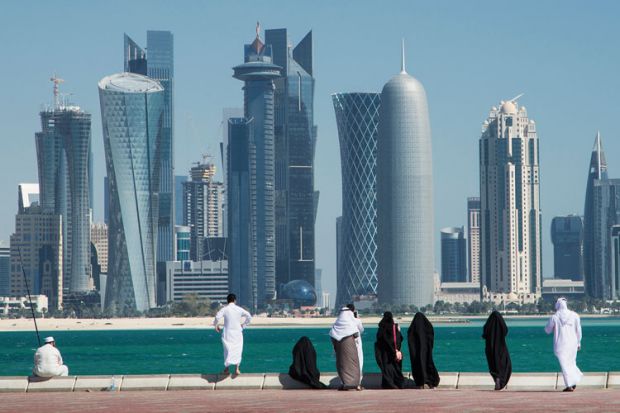Qatar University boasts “a diverse faculty body, with academic qualifications from top universities around the world”, says its vice-president and chief academic officer, Mazen Hasna. The institution, which hosts the inaugural THE Middle East and North Africa (MENA) summit on 23-24 February, estimates that 84 per cent of staff hail from abroad.
Anna Grichting, assistant professor of architecture and urban planning, is one such expatriate. Her tax-free monthly salary is $9,200 (about £71,700 per annum) and her paid-for housing is worth $3,000-$4,000 a month (£1,950-£2,600). The university also pays the costs of relocation, private insurance and annual flights home as well as offering support with school fees.
It was the generous package, combined with the professional opportunities, that drew the Swiss academic to Qatar three years ago. “When I arrived, the master’s programme was just being established, and I was teaching and shaping the programme by finding subjects and themes of research that are important to Qatar. For example, two of my main research areas are food urbanism, and legacies and events, which is apt because Qatar is hosting the Fifa World Cup,” she says.
Bahram Bekhradnia, the president of the Higher Education Policy Institute, has advised governments in Jordan, Yemen, Syria and around the Gulf on higher education reform. He says that although MENA is clearly not a homogeneous region, some of its countries are attractive to academics: “There are lots of opportunities – the most obvious [being the reward] in terms of salary. [Also] in terms of professional development, certainly in some of the countries such as Qatar and the United Arab Emirates, they’re putting a lot of emphasis on research development and making research facilities available.”
Bekhradnia highlights Saudi Arabia’s King Abdullah University of Science and Technology (KAUST), a postgraduate institution founded in 2009 with a $20 billion endowment. KAUST hopes to become one of the world’s top 10 science and technology universities.
Also striving to make its mark, New York University Abu Dhabi (NYUAD) is one of about 40 “satellite” universities in the Middle East. Although small, with just 730 undergraduates, it attracts top academics and other intellectuals to teach for a term. Contributors have included Albie Sachs, a former judge at the Constitutional Court of South Africa, and the Lebanese writer Elias Khoury. NYUAD won’t share figures, but its vice-chancellor, Alfred Bloom (formerly principal of Swarthmore College, Pennsylvania), says “faculty salaries are highly competitive and research funding is generous, compared with US and European benchmarks”.
Despite their high-calibre appointments, Qatar, KAUST and NYUAD have yet to make their mark on the THE World University Rankings (see box below), but the region is growing in confidence. Phil Baty, editor of THE Rankings, comments: “While universities in the region are not troubling the likes of Harvard or Cambridge, in the overall World University Rankings, there is real scope for optimism. The University of Marrakech Cadi Ayyad entered the world top 350 for the first time in the recent global rankings, for example.
“And when you put the rankings into a more appropriate regional or economic context, there are also encouraging signs. In our 2015 BRICS and Emerging Economies Rankings, for example, the UAE has two institutions in the top 100, with United Arab Emirates University taking 71st place, among giants such as China and Russia.”
But not all academics will be rushing to move to the region. Bekhradnia is realistic about the challenges: “First there’s the fact that they’re away from home, family and colleagues. You’ve also got to get used to a different way of working – some people find the hierarchies quite difficult.” And there are, of course, wider issues in some MENA countries. For example, homosexuality remains illegal in much of the region.
If the region does appeal, however, there are opportunities to make an impact.
Baty adds: “The Middle East has a dynamic and exciting higher education, research and innovation sector, with huge challenges but also huge opportunities. With some countries in the region becoming exciting global hubs for international students and making a serious investment in building research infrastructure, and with mounting evidence of pockets of research excellence emerging in key fields in the region, one could argue that we are witnessing an exciting, knowledge-fuelled revival for the region.”
Higher education in MENA at a glance
MENA countries and territories include:
Algeria, Bahrain, Djibouti, Egypt, Iran, Iraq, Israel, Jordan, Kuwait, Lebanon, Libya, Morocco, Oman, Palestine, Qatar, Saudi Arabia, Sudan, Syria, Tunisia, Turkey, United Arab Emirates, Yemen.
Number of new UK graduates taking up teaching or research posts in MENA:
30 per year (2011-13, Higher Education Statistics Agency). Average salary: £28,615 (2012-13)
MENA in Times Higher Education World University Rankings Top 400
- Middle East Technical University, Turkey (rank position 85)
- Boğaziçi University, Turkey (139)
- Istanbul Technical University, Turkey (=165)
- Sabanci University, Turkey (=182)
- Tel Aviv University, Israel (=188)
- Bilkent University, Turkey (201-225)
- Hebrew University of Jerusalem, Israel (201-225)
- Technion – Israel Institute of Technology, Israel (201-225)
- Koç University, Turkey (301-350)
- University of Marrakech Cadi Ayyad, Morocco (301-350)
- Sharif University of Technology, Iran (301-350)
- Isfahan University of Technology, Iran (351-400)

